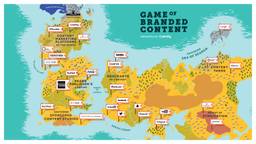Lessons from the Summit: brand publishing
Brand Publishing: Superior to Native Advertising?
During the first week of November, 20,000 technology and marketing professionals descended upon Dublin, Ireland for the Summit – a conference that has quickly become the largest of its kind in Europe. Pilot was there to capture notes, impressions and ideas from this year’s speakers, which included Bono, Peter Thiel and John Sculley. Here, with an eye trained on all things tech and marketing, is the third and final instalment of our three-part series covering the event.
“Everybody has a printing press,” says Shane Snow, co-founder and CCO of Contently, the brand publishing platform that brings freelancers together with brands to create great content. “The Internet has removed a lot of barriers to entry.” With the open nature of the Internet, much of the gatekeeping power of the larger publishers has been eroded. This has resulted in an abundance of content, but also incredible opportunities for brands.
What is brand publishing?
Brand publishing is when a brand becomes its own publisher, feeding its own communities with original content online. This form of editorial storytelling reinforces brand image, but it also allows companies to tailor their content to the customers they want, need, or already have. Some success stories include Red Bull TV, so rich with extreme sports content that it now competes with network stations like ESPN. A few more examples, including Coca Cola, Barney’s New York, and Adobe can be found in this Digiday article – and this Contently infograph is pretty cool, too.
Through brand publishing, brands can build and cultivate their own fan base, nurturing loyal subscribers by offering high-quality content with opportunities to continually expand their audience network. More brands can now own their own media by being a publisher, though it is an expensive, labour intensive undertaking. Due to costs and resources associated with becoming a publisher, many brands have instead opted to try native advertising.
What is native advertising?
Native advertising, or “advertorials,” are content paid for by a brand, disguised as independent content. The work, however, is paid for, like this Barkbox article on the new Annie movie sponsored by Sony Entertainment, or this Buzzfeed quiz about guessing machine sounds sponsored by General Electric, or this New York Times article on women’s jails sponsored by Netflix’s Orange is the New Black.
In a panel on the topic, Mike Copeland of Andreessen Horowitz points out that clicks have gotten more expensive and are returning less on investments, pushing brands to use native ads through popular publishers like the ones noted above. And, while returns do show high click through rates and engagement in terms of time spent with the content, the downside of native advertising is its essence – that the intention behind the messaging, a brand’s call to action, is often so disguised that the reader is unaware of what they’re supposed to do.
So why is brand publishing more effective?
Trust and intention are what set brand publishing apart from native advertising.
Trust
In a survey, Contently found 66 per cent of people said they have felt deceived by sponsored content. In ranking what users thought was the most to the least honest content, the New York Times ranked highest on trust, while Buzzfeed ranked lowest, below product placements in TV shows and magazine advertisements. Without a call to action or clear directives in native advertising, brands must rely on either thought leadership or subliminal messaging to lead audiences to the action they desire – like buying something. This further reduces the trust value of sponsored content, even if it is quality, real reporting.
Intention
Shane Snow explains: “The new currency is the intention of the click.” Native advertising loses the ability to capture audiences with the right intentions, like purchasing a product, for example. How useful is it for Samsung to sponsor a widely read post about South Korean culture if it won’t lead to a single smartphone sale or any brand exposure for Samsung? While the goal of brand exposure is not front of mind for advocacy or cause PR issues, such as environmental or health agencies, the lack of intention to act and the inability to express it limits the effectiveness of native advertising.
This is where brand publishing can be useful to capture audiences who have already opted in to the brand, product, or content. Yes, this may be a smaller audience than Buzzfeed can offer, but they engage with the brand on its own platform, knowing what it is, and with a clear intention to do so, which means audiences are more receptive and productive.
Brand publishers are able to leverage “owned” assets to control their image, message and content. They can use transparency to build trust, and have an audience that is an asset, not a continued expense. As Shane Snow puts it, “build a business through publishing, versus shouting into the hurricane of the Internet.”
